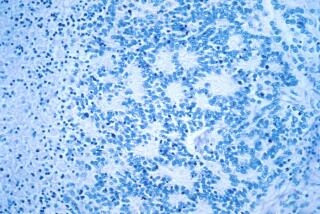Faster Treatment May Have Saved Boy, Experts Say
- Share via
The disease that apparently led to the death of 12-year-old Julio Cano is the most common form of childhood cancer, sometimes leading to aggressive infections and causing death in a matter of months or even weeks, medical experts said Wednesday.
Whether the boy’s life might have been saved by a diagnosis of acute leukemia just a few days earlier remains uncertain. But childhood leukemia specialists say the disease often is treatable, especially if it is caught before complications such as infection or internal bleeding set in.
Experts said Wednesday that they would need to know much more about the boy’s case--including which type of leukemia he had and what his precise history was--before reaching a conclusion on whether his death was preventable.
Even in the latter stages, however, there is generally “some significant chance” of effectively treating acute leukemia in children, said Dr. Stuart Siegel, head of the division of hematology/oncology at Children’s Hospital Los Angeles.
A cancer of the bone marrow and blood, acute leukemia involves the rampant growth of abnormal white blood cells, which essentially crowd out other normal blood cells and invade other body organs, Siegel said. The cause is uncertain, but it is not believed to be hereditary. It might involve some sort of genetic mutation, Siegel said.
In Julio’s case, the disease had affected his spleen, brain, kidney and liver, said Lt. Dan Martini of the Orange County sheriff-coroner’s office.
It was not known how long the boy had the disease, but one official said it could have been weeks to months. His parents said they delayed seeking medical treatment because they are illegal immigrants and feared being deported under Proposition 187. It also was unknown when he developed the bacterial infection that apparently caused his death. More tests are needed to determine how fast the disease progressed.
The disease takes two basic forms. One type, called acute lymphoblastic leukemia, has a survival or cure rate of about 70% after five years, if treatment is provided, Siegel said. The other type, called non-lymphoblastic leukemia, is more difficult to treat and has a 40% to 50% survival rate.
The chances of successfully treating both forms remain reasonably good even if the disease is diagnosed in its late stages, Siegel said. Both forms are treated with chemotherapy, although non-lymphoblastic leukemia also may require a bone marrow transplant.
Symptoms of acute leukemia may include paleness caused by anemia, fever, bruising easily, bone pain, skin rashes and an enlarged liver or spleen. The disease might be developing for a period of months, Siegel said, but symptoms can “come on very quickly. . . . It could happen within a period of a week.”
Because symptoms often occur late, many patients tend not to seek early treatment, he said.
A parent might initially mistake some symptoms for the flu, except the condition “doesn’t go away, “ he said.
Dr. Alexis Thompson, assistant professor in pediatric hematology and oncology at the UCLA School of Medicine, said that an alert general practitioner usually will be able to pick up on the signs of the disease. It is diagnosed using blood tests and bone marrow biopsies.
“There are children who die under the best of circumstances,” she said, even with relatively prompt treatment. She said an aggressive infection--which Julio might have suffered--can overwhelm a child “even before we’re able to give adequate chemotherapy.”
Siegel said the two most common causes of death are infection and internal bleeding.
Acute leukemia affects about 3,200 children a year, accounting for about 40% of all new childhood cancer cases, he said.
Times staff writer Thomas H. Maugh II contributed to this report.
More to Read
Sign up for Essential California
The most important California stories and recommendations in your inbox every morning.
You may occasionally receive promotional content from the Los Angeles Times.













